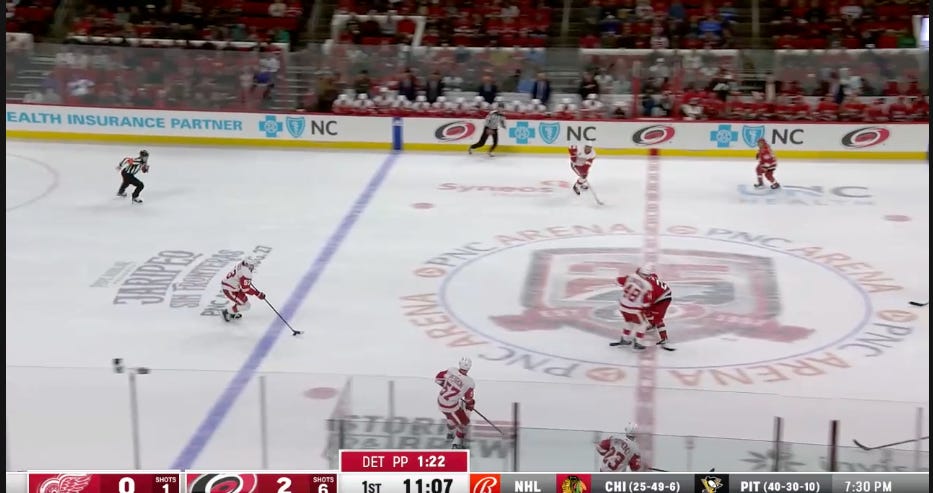Wing Wednesday: The non-negotiable elements of the power play entry
Let's look at the film for the foundation of the power play in Detroit.
Earlier this week, well yesterday, I publicly disclosed the content plan for the 2023-24 season here at Shap Shots.
Part of that includes a Wednesday tactical breakdown/film study of the Detroit Red Wings — hence Wing Wednesdays.
Today I want to take a look at the Red Wings power play, particularly the zone entries, for a unit that finished 17th in the league at 21.1 percent during the 2022-23 season.
Zone entries are for the nerds. You won’t see any goals scored in the clips below, but you can’t build a successful power play without a strong foundation. And if you can’t get into the zone, well, you don’t have a foundation to stand on.
Let’s take a look.
The Red Wings have two “non-negotiable” aspects on the power play breakout. It’s a philosophy stolen from Derek Lalonde’s time with the Tampa Bay Lightning and he used it when he was running the power play for Team USA at the 2023 IIHF World Championships.
Break out together
Finish your routes together
It’s a swarm mentality, attack with strength, and avoid solo runs without the rest of your teammates.
When the Red Wings power play is clicking, these non-negotiable elements are pretty easy to track.
You’ll notice all five players in the 200-foot buildup from the defensive zone. The entire unit hits the blue line in sync with the puck carrier, and the non-puck carrying players continue skating paths into the zone.
Let’s talk about some specifics and nuance, remembering that “Break out together,” and “Finish your routes together,” are guiding principles that Lalonde and assistant coach Alex Tanguay preach to their players.
Coming through the neutral zone, in an ideal setup, there will be a moment, like this one, where all five players are on the defensive side of the redline.
You’ll notice in the screen grab below all five Red Wings have their heads tracking the puck carrier, Moritz Seider, to time routes.
From this space the Red Wings will setup the second part of their typical double-drop pass. Seider (No. 53 in white) will move attack the space through the middle, draw a defender and leave the drop for a forward that has circled back.
Here’s an example from later in that same game, where Seider has moved into the space and is leaving the double-drop for Lucas Raymond (who is back in the Detroit defensive zone).
This is where a secondary, sub-guiding principle comes into play for the Red Wings on the entry.
Hunt the pick.
Now, pick plays are technically illegal in hockey — it is the definition of interference. But like holding in football, it happens on almost every play, and officials are often scared to call it.
The Colorado Avalanche, for example, use little pick plays in the offensive zone better than most teams.
In Detroit, after making the drop, Seider’s job in the screen grab above is to hunt the pick and take an opposing defender out of the play.
Look at this screen grab below, where Seider (near the blue line, No. 53) isn’t skating at the Hurricanes defender, but he’s also doing everything in his power to impede the route and open space for Raymond.
Here’s a clip from another Detroit game, this one against the Montreal Canadiens, that features hunting the pick. Focus on watching the center of the blue line as Dylan Larkin, the puck carrier, reads off where his teammate has set the pick.
Part of the ideology behind the pick plays and the double-drop, is forcing the opponent to adjust speeds and shift frequently, potentially getting the gears all clogged up.
Here is a great visual of one variation of the double-drop from my Expected By Whom? co-host Prashanth Iyer.
The penalty killers will often match the speed of the power play entry, stop with the stall at the defensive blue line, and then have to ramp up again to deal with puck carrier.
In that above clip you’ll notice the circle back from Larkin, who is intentionally circling back into this box, which is poorly drawn below.
The circle back into this box is vital. It allows Detroit to follow the second guiding principle of Lalonde’s power play, “finish your routes together.”
The other four players are now able to finish their routes, while Larkin has created a second shift, or stall, that the penalty killers have to adjust for.
Here is another example, this time from a different game against the Hurricanes.
Another goal of this entry strategy is to make it more difficult for the opponent to setup the penalty killing box, create some confusion, and potentially some additional seams that are more difficult to close.
We’ll talk more about the in-zone power play setup and look at some actual goals next week.
(Editor’s note: this type of story will typically be for paid subscribers only. But this week and next with the film/breakdowns I’m keeping them open for those on the fence to give the coverage a try. Thanks again for your support.)






Really enjoyed reading this and will pay closer attention to their PP zone entry this season. Thanks for the great content.